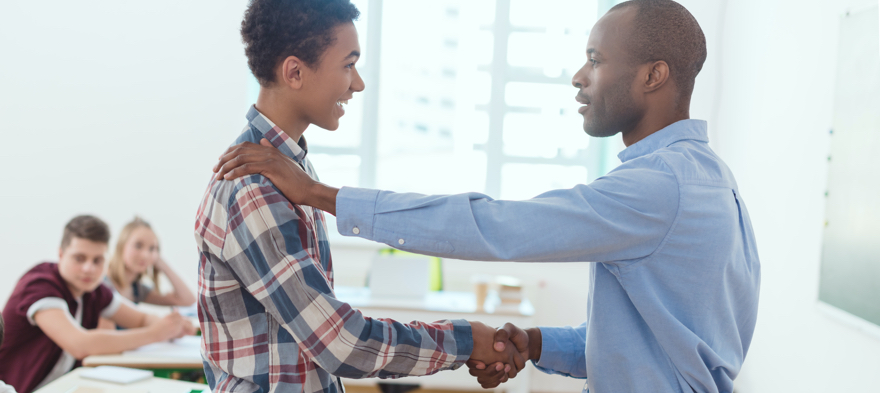
May 13, 2020 12:00:00 AM
by Mark Gudgel
Handshakes are a deeply ingrained part of our society, and they play an important role in daily life. Handshakes, or one of their various cultural equivalents, such as dap, can be greetings that signify warmth, teamwork and camaraderie.
As a high school English teacher, my custom for 16 years has been to greet kids at the door to my classroom and shake their hands as they enter. We practice a firm handshake, eye contact and even smiling. It isn’t always easy with the distractions of life going on all around and even inside of us, but the role of this gesture in our society is such that I teach my students we need to learn to do it, even when we may not wish to. “Nobody is going to reschedule an interview for any job you actually want just because you’re grumpy.”
For years now, I’ve been gratified by emails and social media messages coming from former students, contacting me after landing jobs with law firms, Fortune 500 companies, and even professional sports teams, thanking me for teaching them to shake a hand and look another person in the eye. Moreover, our handshakes each day signify an understanding between my students and me: It’s time to get to work. It has, up to this point, been one of the simplest yet most meaningful things that I do every day in my classes.
But what will it look like when we at last return to school after a global pandemic? And what will that mean for the relationships we build with others? Dr. Anthony Fauci, America’s leading expert on infectious diseases, who has—willingly or otherwise—become the face of the COVID-19 outbreak in America, wants handshakes done away with completely—and he’s not alone. But [pullquote]what will a world without dap, a world without handshakes, hugs or high fives, even look like?[/pullquote] You can’t elbow bump—you might as well be necking if you’re that close, and as a teacher, I should forget about placing a comforting hand on the shoulder of a distraught young person. But can we really get back into brick and mortar schools with “keep a safe distance” as our mantra? I have my doubts.
True—handshakes are not a customary greeting between teacher and student in most schools, and while I’ve already explained the rationale behind my practice of shaking students’ hands, it is difficult to imagine doing away with that—perhaps in favor of standing behind a podium with an apple balanced atop it, a yardstick in my hand, taking attendance? Maybe I’ll practice balancing spectacles at the end of my nose. Regardless, can we have school without handshakes? Yes. Can we figure out how to conduct job interviews without handshakes? We already have. But for schools, the issues run far deeper than that.
I recently recorded a lesson of “Teacher TV” with my friend Carl to air on public television here in my home state of Nebraska. As we spoke, Carl pointed out that the term “social distancing” is problematic, and he told me he prefers “physical distancing.” This resonated with me.
In scary times—like a pandemic, but also post-pandemic—[pullquote]the last thing we want is to feel socially distant from those who support us.[/pullquote] As teachers, administrators and public officials start to put school back together, I think we would do well to consider that what is needed is not social distance, but physical distance. If anything, the social distance should be minimized as much as possible.
It seems very likely that, among the long-term impacts of the COVID-19 pandemic, will be the yet-to-be-defined alterations to social interactions, in particular those that involve physical touch and close proximity with others. One thing I will say is that if handshakes are to become a casualty of the pandemic, a verdict that I am prepared if not excited to receive, then I will expect whoever issues that order to be equally diligent in ensuring that my students and I are able to maintain a minimum six feet of distance between our persons at all times. In my little classroom, that will translate to class sizes of about ten. I suppose I am willing to trade in handshakes for that.
Dr. Mark Gudgel has been a public secondary school teacher for 16 years. Presently, Gudgel teaches English, Humanities and World Religions at Omaha North High Magnet School, and is an adjunct professor with the M.Ed. program at Nebraska Wesleyan University. He was a finalist for Nebraska’s Teacher of the Year Award in 2020. A Fulbright Scholar and fellow of the United States Holocaust Memorial Museum and Imperial War Museum, Gudgel has devoted much of his career to teaching about social justice and civil rights. When he's not teaching, Gudgel is an avid runner, writes poetry, a wine blog and various essays. He lives in Omaha with his wife, Sonja, and their children, Titus and Zooey.
Few issues in education spark more tension and debate than standardized testing. Are they a tool for equity or a burden on students? A necessary check on school systems or a flawed measure of...
Charter schools are public schools with a purpose. Operating independently from traditional school districts, they're tuition-free, open to all students, and publicly funded—but with more flexibility...
Despite the benefits of a diverse teaching force, prospective teachers of color fall out of our leaky preparation pipeline at every stage: preparation, hiring, induction, and retention. Here’s what...
Ed Post is the flagship website platform of brightbeam, a 501(c3) network of education activists and influencers demanding a better education and a brighter future for every child.
© 2020-2025 brightbeam. All rights reserved.
Leave a Comment